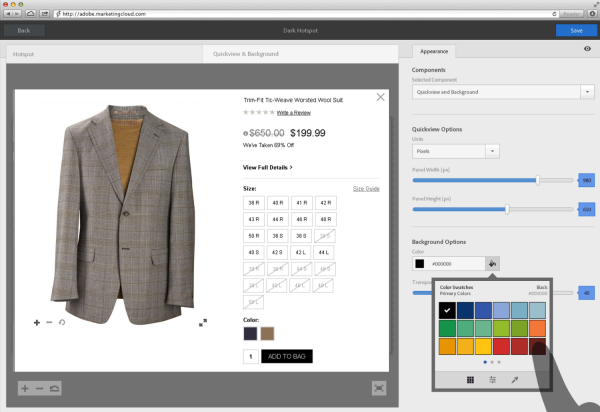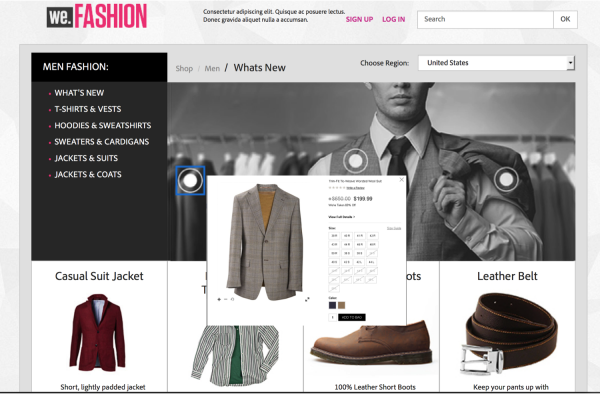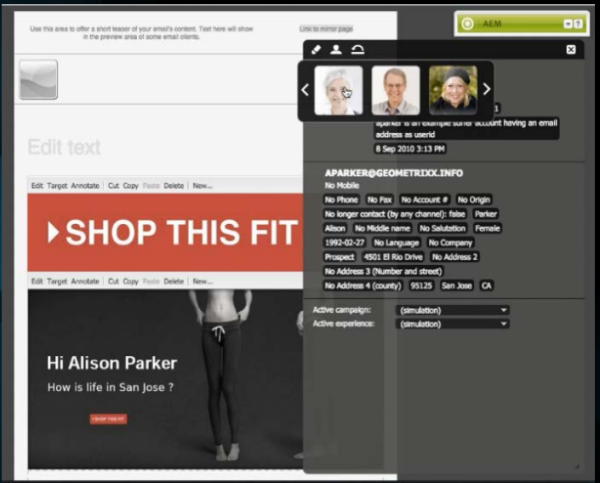Adobe Campaign Integrations Take Personalized Experiences Further
by Barb Mosher Zinck | January 12, 2015 10:58 am
Adobe kicks off a new year with key integrations for Adobe Campaign. Kerry Reilly, Director of Product, Adobe Campaign walked me through the updates and here’s a snapshot of what’s new and improved.
It starts with three important integrations with other Adobe solutions:
Adobe Campaign and Experience Manager
Marketers have the ability to create more personalized rich media experiences with this integration whether it’s web, email, kiosks or something else. It’s actually pretty cool what you can do. With a drag and drop UI, you can create hotspots on rich media, that when clicked will open a pop-up with product details. This part isn’t new to shopping experiences, but it’s great functionality because you can view details, add something to your shopping cart and not lose the place you were in.
How about personalizing images? With this integration you can put a personalization field on an image and when a visitor views the image it will show their name based on information Adobe has about the visitor.
Adobe Campaign and Adobe Target
Now let’s talk email, because it’s the best way to reach customers. With its integration with Adobe Target, marketers can now create contextually relevant emails. So no matter where you are, when you open, or look at an email it will show information relevant to your current situation. Some examples Reilly offered included location-based news and images and relevant, personalized offers.
Consider the email you may have received but didn’t open that included an offer that has expired. The marketer can now remove the offer and either replace it with a new one, or place a message that the offer has expired. Or, a marketer could tailor the offer based on the user’s known preferences and experiences stored in Adobe Target.
The key to this level of personalization is that person is online when they open the email to have it personalized, but in most cases this will true.
Adobe Campaign and Analytics
There’s two parts to this one. First Adobe Campaign is now sharing its audiences and profiles across the marketing cloud, so there’s one place where all the profile information is stored. Audiences and profiles use to be known by a different name: master marketing profile, but that’s changed. Now you can build a visitor profile in real-time with things such as location, devices, website behavior, searches, mobile usage and more and leverage the profile to trigger something in Adobe Campaign, like an email or a push notification. Trigger examples include interest in a product/offer, an iBeacon, or completion of a form.
Shared Audiences can also be leveraged by Adobe Media Optimizer, helping marketers present the most relevant display advertising based on what’s known about the user. In this case, a visitor doesn’t have to look at an ad for a table they already bought because Media Optimizer can now access information about the visitor and know they bought it. Instead they can opt to show something different. Here again is personalization at it’s best because the markers now knows if the visitor is a frequent email opener, a Gold customer, an inactive customer, a key prospect or has already purchased the item to be shown. If you don’t have that much information about the visitor, you can also show ads based on defined audiences and not the specific visitor.
Adobe’s Digital Shopping Index
Along with the integrations for Adobe Campaign, Reilly also spoke about the new Adobe Shopping Index. During November and December of 2014, over US$73 billion sales were done online, up 12% from the previous year.
Of this revenue, mobile accounted for 16%. And it’s not all tablets either. With some smartphone screens getting bigger, smartphones are being used more for online shopping, in this case their use was up a third from last year and accounted for almost half of all mobile ecommerce.
Buying online and picking up in the store was another big thing, allowing people to make purchases during non-store time, but not have to wait for the purchase to arrive in the mail.
iBeacons are becoming more welcome as well. 55% said they were open to receiving notifications on deals while in the store. Of course there is still concern over the quality of personalization efforts, and in some cases whether ads should be personalized at all.
My last note on the Digital Index (and there is more you can read about) is on digital wallets. According to the report, 35% of consumers are able to use their mobile phone to make payments in the store and 47% of these consumers actually did just that. They are still not sure about storing credit card information on their actual phone though. Payment methods such as PayPal, Amazon Payments and Google Wallet were often used.
The Key Takeaways
This news and more is being announced today at the National Retail Federation (NRF) Big Show. What seems clear is that 2015 is going to focus heavily on getting personalized experience right. That requires an intimate level of knowledge of a visitor, something not everyone is happy about. But if it’s done right, many will appreciate experiences tailored to them in sea of information that hits them daily.
These master profiles that vendors are now building are also very interesting. I could see storing not only information about the visitor and what they’ve done, but also what a vendor has shown them. Consider seeing the same ad fifty time and still not being interested, or having that ad change based on other things you are interested in. I’d be on board for that one.
Share and Enjoy
Source URL: https://digitaltechdiary.com/adobe-campaign-integrations-take-personalized-experiences/1422/



